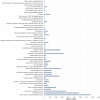Differential microRNA expression profile in blood of children with Down syndrome suggests a role in immunological dysfunction
- PMID: 35060072
- PMCID: PMC8773395
- DOI: 10.1007/s13577-022-00672-x
Differential microRNA expression profile in blood of children with Down syndrome suggests a role in immunological dysfunction
Abstract
Down syndrome (DS), caused by trisomy of chromosome 21 (HSA21), results in a broad range of phenotypes. However, the determinants contributing to the complex and variable phenotypic expression of DS are still not fully known. Changes in microRNAs (miRNAs), short non-coding RNA molecules that regulate gene expression post-transcriptionally, have been associated with some DS phenotypes. Here, we investigated the genome-wide mature miRNA expression profile in peripheral blood mononuclear cells (PBMCs) of children with DS and controls and identified biological processes and pathways relevant to the DS pathogenesis. The expression of 754 mature miRNAs was profiled in PBMCs from six children with DS and six controls by RT-qPCR using TaqMan® Array Human MicroRNA Cards. Functions and signaling pathways analyses were performed using DIANA-miRPath v.3 and DIANA-microT-CDS software. Children with DS presented six differentially expressed miRNAs (DEmiRs): four overexpressed (miR-378a-3p, miR-130b-5p, miR-942-5p, and miR-424-3p) and two downregulated (miR-452-5p and miR-668-3p). HSA21-derived miRNAs investigated were not found to be differentially expressed between the groups. Gene Ontology (GO) and Kyoto Encyclopedia of Genes and Genomes (KEGG) enrichment analyses showed potential target genes involved in biological processes and pathways pertinent to immune response, e.g., toll-like receptors (TLRs) signaling, Hippo, and transforming growth factor β (TGF-β) signaling pathways. These results suggest that altered miRNA expression could be contributing to the well-known immunological dysfunction observed in individuals with DS.
Keywords: Blood mononuclear cells; Down syndrome; Immune system; Trisomy 21; microRNA expression.
© 2022. The Author(s) under exclusive licence to Japan Human Cell Society.
Conflict of interest statement
The authors declare that they have no conflict of interest.
Figures




References
MeSH terms
Substances
Grants and funding
LinkOut - more resources
Full Text Sources
Medical

